World Argentina
Altura Maxima
Colomé, Argentina. Facing the Nevado de Cachi, which rises to 6,380 metres, the world's highest vineyard, Altura Maxima (3,111 metres) is surrounded by a dry stone wall raised by an Indian who has spent his whole life on the slopes of the mountain. This is the land of the Calchaquis, in the Cordillera de los Andes in northwestern Argentina, in the heart of the province of Salta. In other words, in the middle of nowhere...

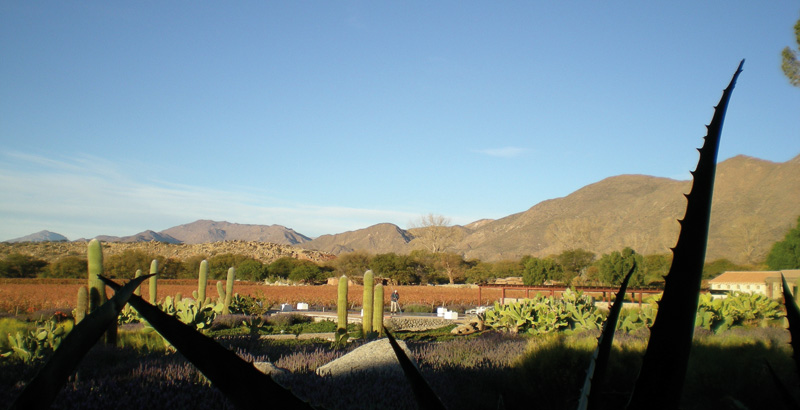
Seen since the terrace since my room in Estancia Colomé.
From Salta, which is a little over two hours by plane from Buenos Aires, one must drive some five hours over poorly maintained roads - for the most part, mere tracks of sand and pebbles – winding their way through wildly beautiful, uninhabited landscapes in order to finally reach the small town of Payogasta. Altura Maxima, located 20 km away on the opposite side of the valley, blends into its mountainous setting.
Before making out the vines and their ever-present trellis stakes, one is struck by the aridness of the soil dotted here and there with rocks, the occasional clump of esparto grass, thorny shrubs and majestic cardóns, the famous giant candelabra-shaped cacti. In the very heart of this steppe lies the world's highest vineyard, with 1 ½ hectares planted with Pinot noir and Chardonnay. As an experiment, there are an additional 25 hectares a few metres lower down planted with Sauvignon blanc, Malbec, Syrah, Petit verdot, Tempranillo and Merlot.
It was in 1999 that Donald Hess, who had fallen in love with this region of Argentina and its powerful Malbecs, acquired 350 hectares of virgin land. After locating abundant water, he decided to set up his first vineyard, Le Arenal, covering 30 hectares at an altitude of 2,600 metres. Malbec, for the most part, and some Cabernet Sauvignon have been in full production since 2003. However, this is not yet the case for the Altura Maxima vines...
 Caspar Eugster, person in charge of the infrastructure and the vineyard
Caspar Eugster, person in charge of the infrastructure and the vineyard
of Altura Maxima, and Michèle Chantôme in front of the vineyard in front
of Nevado de Cachi. 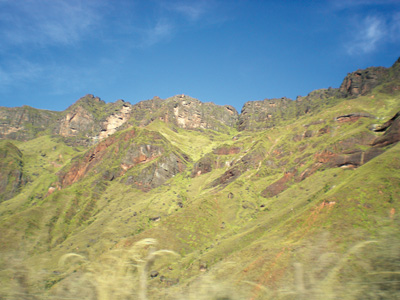
The water, the gold of the region.
A challenge
Caspar Eugster is living a one-of-a-kind adventure at 3,111 metres above sea level. He is the manager of what I would call the vineyard's "biodynamic-eco-aesthetic" project, for in this remote corner of the world, one must be self-reliant, preserve the landscape and plant vines at ever higher altitudes. In this location worked for centuries by Indian farmers who grew alfalfa to feed their livestock, Inca ruins have been discovered: in particular, an acequia, a small irrigation canal, evidence of extensive agricultural activity during the pre-Columbian period. At Altura Maxima, this same irrigation system has been taken up and improved, for the channelled water also powers a water turbine to produce the electricity needed by the estate. Reservoirs have been created against the mountain slope and all infrastructure blends into the surrounding setting. Everything is hidden, thereby preserving the landscape's natural beauty. The cardóns are still there and the property will soon welcome sheep and lamas. Of course, it has not been easy to achieve this unobtrusive result. Indeed, it has proven to be a real challenge. And one is amazed by the technical feats carried out without harm to the environment and that allow for not only drip irrigation, but also sprinkling of the vines to prevent frost..
"Water is worth its weight in gold here," confides Caspar, "There is practically no rain (5 to 12 cm maximum per year) and temperatures in the winter fall to -5° or -10° C at night and rise to 15° or 20° during the day, while during the summer, the temperature is 10° at night and over 30° during the day."
These great variations in temperature are what make winegrowing worth while at such an altitude! The grapes mature more slowly. The intense ultraviolet rays encountered at very high altitudes influence the development of pigments, tannins, aromas and polyphenols. Acidity is also assured, rendering the wines all the more balanced. Not to mention the fact that these famous polyphenols present in the Malbecs and Cabernet Sauvignons grown at altitude in the Andes are the richest in the world, according to Professor Corder of London's William Harvey Research Institute, who insists upon the positive effects of red wine for blood circulation. Argentina's version of the French Paradox? Drinking responsibly, one can take care of one's heart while enjoying oneself!
At an altitude of 3,111 metres, Altura Maxima will not produce grapes for vinification before two or three years' time, for while the 2007 harvest at 3,050 metres proved promising, the 2008 and 2009 frosts decided otherwise. However, the other high-mountain vineyards of El Arenal (2,600 m), Colomé (2,300 m) and La Brava in Cafayate (1,750 m) have produced red and white wines that have been awarded over 90 points in the Wine Spectator and by Robert Parker
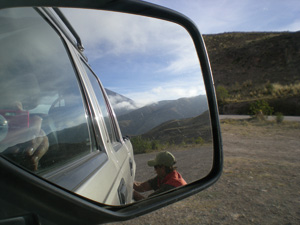
Halfway, in some 3,000 meters in height,
my driver verifies the state of tires worsened on these rocky tracks.Argentina's oldest bodega
The secret? A look back through history is in order, for in this region, the Spanish conquistadors - who overthrew the Incas, who themselves had colonized the Calchaquis - had the excellent idea to import grapevines, as they did in other corners of the Americas. In addition to the recognized qualities of grapes grown at altitude can be added the age of the vine and traditional savoir-faire. The Indian chief Colomin is thought to have planted the first vines at the end of the 16th century. Of course, these original vines are no longer producing wines, but the old Colomé cellar was built in 1831, the first in Argentina. In addition, over four hectares of pre-phylloxera Malbec and Cabernet Sauvignon vines still exist, imported from France and planted here in 1854. These same varietals, between 60 and 120 years of age, cover an additional 7 hectares. These invaluable, non-grafted vines allow for the annual reproduction and replanting of vine stocks (without rootstocks), thereby continually renewing the vineyard. The family that owned the Colomé estate until its acquisition in 2001 by Donald Hess took very good care of its vines, producing an excellent Malbec wine.
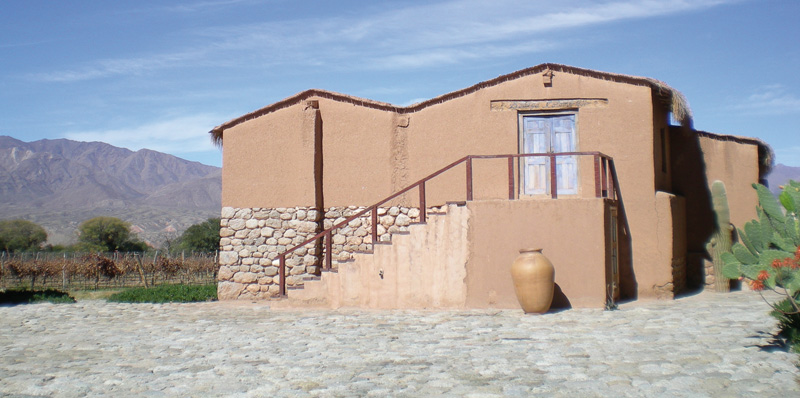
The former Bodega built in 1831.
"Traditionally, these wines are very powerful and occasionally rather rustic," explains Thibaut Delmotte, the oenologist at Colomé, "That's why we use new, French-oak barrels that allow us to smooth out the tannins and obtain more elegant wines." I was honestly astonished by the wines I had the pleasure of tasting, and was seduced by their balance, subtlety and complexity, despite a definite concentration and a high alcohol content of between 13 and 15%!
High-altitude wines
Torrontés, Argentina's emblematic white wine varietal – a cross between the Muscat of Alexandria and the Criolla or "mission grape" – is here able to fully express its aromas of rose and orange blossom. The sunshine, the great swings in temperature, the dry climate and fermentation at low temperature (12° C) lend this wine its lovely complexity, while heightening its fruitiness. No barrel ageing, to preserve this wonderful freshness.
Amalaya, a blend of 70% Malbec, 20% Cabernet Sauvignon, 5% Tannat and 5% Syrah, means "hoping for a miracle" in the language of the Mapuche, the Indians who inhabited this region prior to the Cachaquis. This wine also presents a marked fruitiness, despite its spicy overtones. Its aromas are highly concentrated - thanks, in part, to the utilization of micro-oxygenation - and are not dominated by the wood despite the wine's maturing in barrels that are "not always new," as Thibaut tells me. "But the wood is necessary to smooth out the tannins and lighten the colour." And the Tannat? "My best blender!" he answers without hesitation,
"It provides greater acidity than the Malbec, a lot of fruit and spices. It refreshes the wine."Thibaut Delmotte, a native of Burgundy, studied viticulture and oenology in Beaune and, after Santenay and Chablis, he learned the art of blending in the Bordeaux wine country, in Fronsac, Margaux, Pomerol and Pessac-Léognan. On holiday in Salta in 2005, he joined Colomé for harvesting and ended up staying. For him, too, it amounts to a unique experience, at the end of the world... with, as his consultant, Randle Johnson, the Californian winemaker for the Hess Collection.
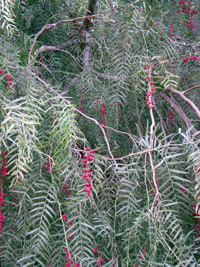
Peppery aromas
Colomé Reserva 2005: 80% Malbec and 20% Cabernet Sauvignon harvested among 100- to 150-year-old vines. A rare wine, in terms of both quantity and quality, that will leave you speechless. Even superlatives fall short... Simply a great wine. Very concentrated, complex, with aromas of spice and pepper and black fruit flavours. I wonder if the peppery aromas come from the estate’s abundant wild pepper trees, especially as they come into flower at the same time as the grapevines... Thibaut continues, "Malbec is really the king of varietals in Argentina and here it is given optimal expression. Cabernet Sauvignon can sometimes prove disappointing, except among these old vines."
Colomé Malbec Estate 2007 (85% Malbec, 7% Cabernet Sauvignon and 8% Tannat) takes after its older sister. It is a powerful Malbec, with aromas of blackberry, blackcurrant, spice and pepper. The Tannat strengthens its acidity and the Cabernet intensifies its roundness. With concentration, balance and length in the mouth, this wine should be aired before tasting and demonstrates good aging potential.
As a general rule, and so as not to thwart the beneficial effects of high-altitude, biodynamic winemaking, the grapes are processed with delicate care. Harvesting, in March and April, is carried out entirely by hand; de-stemming, sorting, pressing and maceration are carried out at a low temperature in stainless-steel vats. After four days for the reds, the temperature is raised and the wine is left to ferment for two or three weeks, with frequent pumping-over to favour polyphenolic extraction. Following malolactic fermentation, which is carried out in vats or casks, the wine is matured in Taransaud French-oak barrels for fourteen to twenty-four months. American oak is not at all suited to the style of wine sought here.
The pink bays of the false pepperpots
 The path which leads to the museum James Turrell
The path which leads to the museum James Turrell
allows to discover the diverse vines cultivated to Colomé.
 Altura Maxima in front of Nevado Cachi.
Altura Maxima in front of Nevado Cachi.The art of wine, the art of light,
the art of living...
Another unique experience awaits us in Colomé: the James Turrell Museum, inaugurated in April 2009, just a few months prior to my visit. A true, thrilling discovery covering nearly 2,000 square metres. Nine monumental installations by this lighting genius, in a building he himself designed, carry you into an unreal world. It is difficult, nigh impossible to describe what one discovers in this museum that is anything but traditional. The works are created via a delimitation of space by lights of varying intensity and colours that cross and are crossed by the visitor. I can certainly say that one leaves transformed by this "visit". One is moved to reconsider the authenticity and appearance of things, and, without necessarily going so far as to philosophize, one is, at a minimum, tempted to relativize very seriously.
The museum is earth-coloured, like the houses of the neighbouring villages belonging to the Indians who work on the estate, whether on the farm, among the vines or at the Estancia, a hotel built around an old bodega dating from 1831, a sober example of the Spanish colonial style of architecture. A luxurious manor house, with a patio, veranda and swimming pool. Spacious, well laid-out and tastefully decorated, with touches of local Indian craftwork, an excellent cuisine and a warm welcome by Gloria... A haven of peace and comfort. Meals are served on the terrace, in the shade of a pepper tree over 150 years old and overlooking vines of the same respectable age. Local, reinterpreted Andean cuisine, made from fish, meats and organic vegetables fresh from the farm, in perfect harmony with the estate's wines. High up in the pure blue sky, a condor soars past... We are already at an altitude of 2,300 metres. A magnificent base camp from which to explore Altura Maxima!
Altura Maxima, Bodega Colomé, is part of Hess Family Estates Ltd., founded in Bern, Switzerland in 1844. Its current, 4th-generation president, Donald Hess, a charismatic visionary, has piloted his group's evolution from beer to mineral water (Valser) to wine. His passion for great New World wines and contemporary art is evident at all of his estates, as much at Glen Carlou (Paarl, South Africa), as at Peter Lehmann Wines Ltd. (Barossa Valley, Australia), The Hess Collection Winery (Napa Valley, California), Artezin (Napa) or Sequana Vineyards (Russian River Valley, California).
Michèle Chantôme








